QuickLinks:
2350, 2351, 2352, 2353, 2354, 2355, 2356, 2357, 2358, 2359, 2360, 2361, 2362, 2363, 2364, 2365, 2366,
2367, 2368, 2369, 2370, 2371, 2372, 2373, 2374, 2375, 2376, 2377, 2378, 2379, 2380, 2381, 2382, 2383,
2384, 2385, 2386, 2387, 2388, 2389, 2390, 2391, 2392, 2393, 2394, 2395, 2396, 2397, 2398, 2399
Page last updated Aug 23, 2023 (Added Caldwell & other IDs for NGC 2362)
Page last updated Aug 22, 2023 (Added Caldwell & other IDs for NGC 2360)
Page last updated Aug 16, 2023 (Added Caldwell and other IDs for NGC 2392)
Last prior update Aug 19, 2019
Updated NGC 2371/72 to take advantage of HST image
WORKING 2351: Add basic pix, tags
NGC 2350 (= PGC 20416)
Discovered (Jan 18, 1874) by douard Stephan (6-6)
A 12th-magnitude lenticular galaxy (type S0/a) in Canis Minor (RA 07 13 12.1, Dec +12 15 59)
Based on a recessional velocity of 1910 km/sec, NGC 2350 is about 90 million light years away. Given that and its apparent size of 1.3 by 0.7 arcmins, it is about 35 thousand light years across.
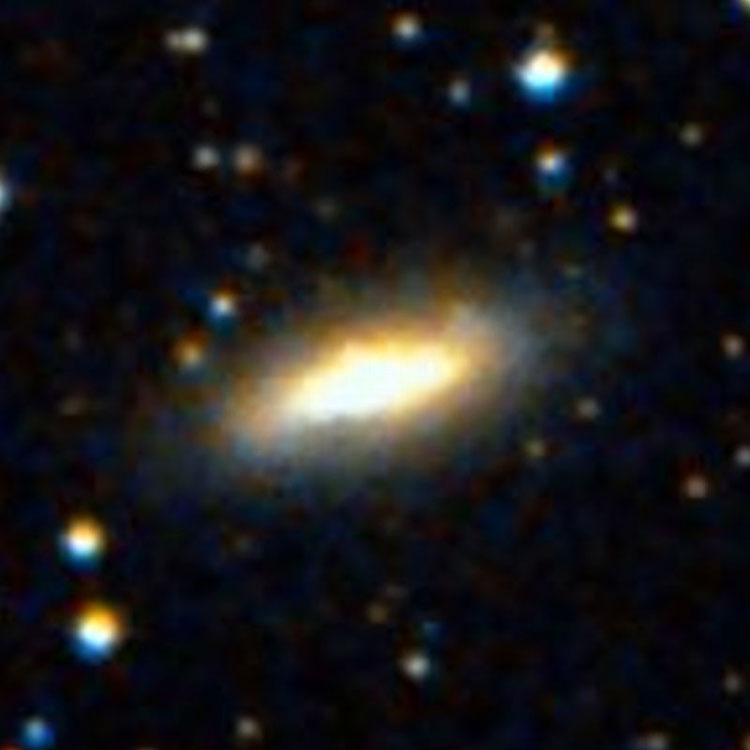
Above, a 2.4 arcmin wide closeup of NGC 2350
Below, a 12 arcmin wide region centered on the galaxy

NGC 2351
Discovered (Mar 9, 1828) by John Herschel
A group of stars in Monoceros (RA 07 13 30.0, Dec -10 28 58)
NGC 2352
Discovered (Mar 6, 1785) by William Herschel
A group of stars in Canis Major (RA 07 13 05.7, Dec -24 02 20)
Apparent size 5.0 arcmin
NGC 2353 (= OCL 567)
Discovered (Jan 10, 1785) by William Herschel
A 7th-magnitude open cluster (type II2p) in Monoceros (RA 07 14 30.3, Dec -10 15 57)
Apparent size 18 arcmin
NGC 2354 (= OCL 639)
Discovered (Mar 6, 1785) by William Herschel
A 7th-magnitude open cluster (type III2m) in Canis Major (RA 07 14 10.0, Dec -25 41 24)
Apparent size 18 arcmin
NGC 2355 (= NGC 2356 = OCL 496)
Discovered (Mar 8, 1784) by William Herschel (and later listed as NGC 2356)
Discovered (Mar 16, 1784) by William Herschel (and later listed as NGC 2355)
A 10th-magnitude open cluster (type II2p) in Gemini (RA 07 16 59.2, Dec +13 45 00)
(only historical information will be covered at this entry; for physical data and images see NGC 2356)
NGC 2356 (= NGC 2355 = OCL 496)
Discovered (Mar 8, 1784) by William Herschel (and later listed as NGC 2356)
Discovered (Mar 16, 1784) by William Herschel (and later listed as NGC 2355)
A 10th-magnitude open cluster (type II2p) in Gemini (RA 07 16 59.2, Dec +13 45 00)
Apparent size 8.0 arcmin
NGC 2357 (= PGC 20592)
Discovered (Feb 6, 1885) by douard Stephan (13-27)
A 13th-magnitude spiral galaxy (type Sc) in Gemini (RA 07 17 40.9, Dec +23 21 23)
Apparent size 3.6 by 0.5 arcmin
NGC 2358
Discovered (Dec 31, 1785) by William Herschel
An open cluster in Canis Major (RA 07 16 56.3, Dec -17 07 00)
Apparent size 8.0 arcmin
NGC 2359, Thor's Helmet
Discovered (Jan 31, 1785) by William Herschel
An 8th-magnitude emission nebula in Canis Major (RA 07 18 30.0, Dec -13 13 30)
(Historical: The second IC says "RA is 1 minute too small (W.H. was right). 2361 is one of the points of condensation".) NGC 2359 is a bubble-like nebula about 30 light years across and 15 thousand light years away, which is energized by stellar winds blowing away from a Wolf-Rayet star near its center. Such stars are high-mass Main Sequence stars (blue giants) and have very short lifetimes, so they are relatively rare at any given time, since most of them have already died in supernova explosions. Surrounding the bubble are complex bow-shock structures created when the millions of miles per hour stellar wind pushed the expanding bubble of gas into surrounding clouds of gas and dust. Apparent size 9.0 by 6.0 arcmin (for central bubble) 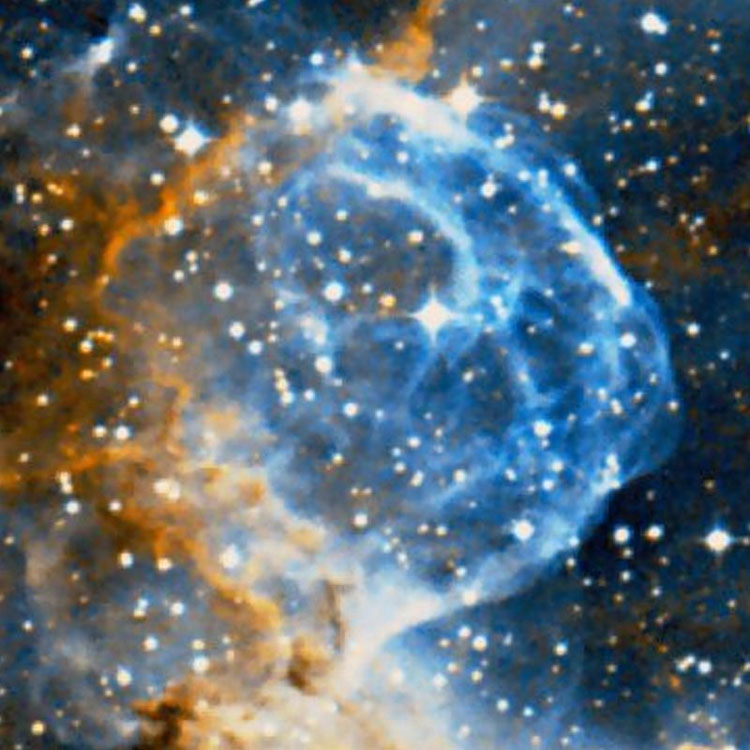
Above, a 6 arcmin wide closeup of the central bubble
Below, a half degree wide view of the region around NGC 2359
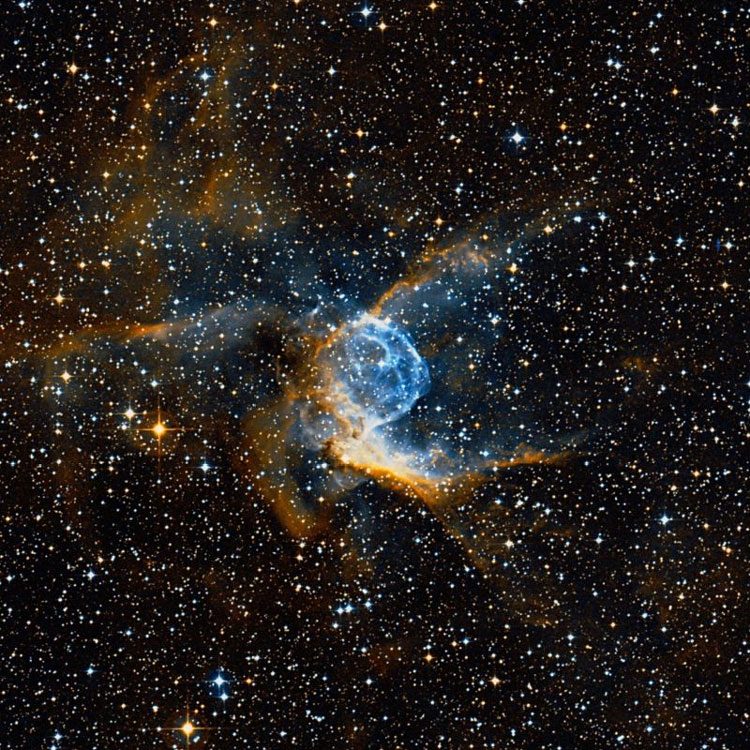
Below, a spectacular image of the nebula
(Credit & © Jean-Charles Cuillandre (CFHT) & Giovanni Anselmi (Coelum Astronomia), Hawaiian Starlight; used by permission)
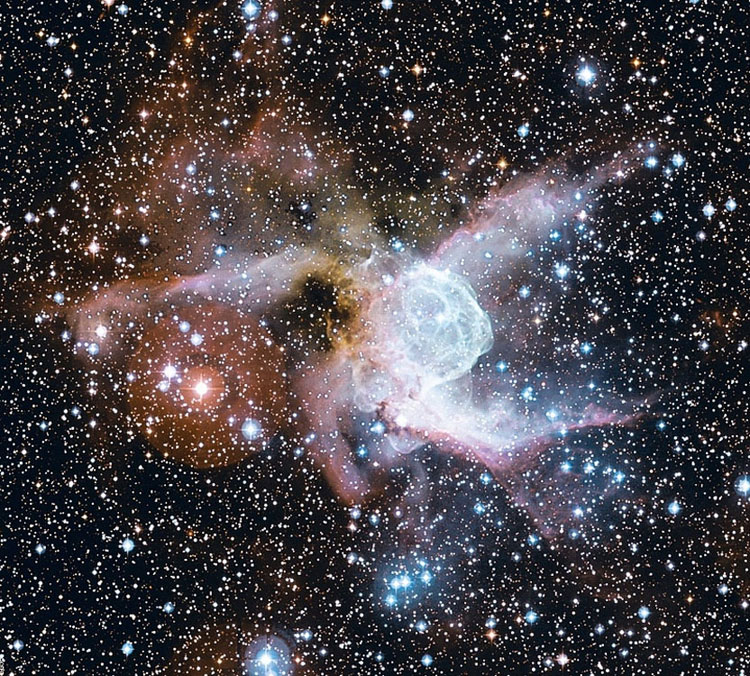
NGC 2360, Caroline's Cluster
(= C58 = OCL 589 = "PGC 3518215")
Discovered (Feb 26, 1783) by Caroline Herschel
A 7th-magnitude open cluster (type II2m) in Canis Major (RA 07 17 44.0, Dec -15 38 15)
Per Dreyer, NGC 2360 (= Caroline Herschel, 1860 RA 07 11 23, NPD 105 23.3) is a "cluster, very large, rich, pretty compressed, stars from 9th to 12th magnitude". The position precesses to RA 07 17 44.0, Dec -15 38 15, which is near the center of the 14 arcmin wide cluster, so the identification is certain (and given the uncertainty involved in specifying the "center" of such a cluster, is used as its position above.)
Discovery Notes: Herschel's published papers list the date of his first observation of WH VII 12 as Feb 4, 1785, but according to Steinicke, that was superseded by Caroline Herschel's observation of Feb 26, 1783, as shown above.
PGC Designation Note: As usual for NGC objects, HyperLEDA assigned a PGC designation to this object, even though it isn't a galaxy; but also as usual in such a situation, a search of the database for that designation returns no result, so the designation is in quotes.
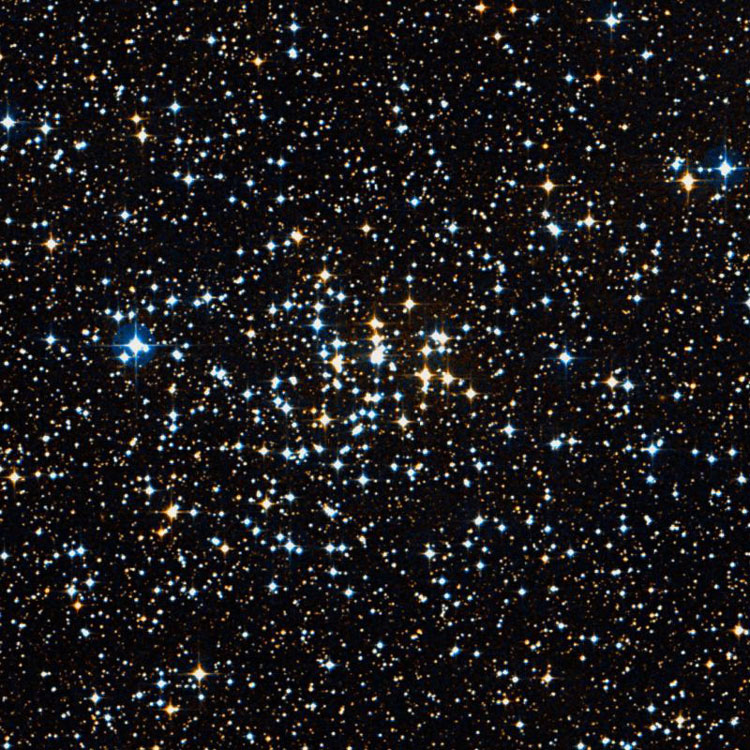
Above, a 20 arcmin wide region centered on NGC 2360
NGC 2361 (= a part of NGC 2359, Thor's Helmet)
Discovered (1877) by Wilhelm Tempel
An emission nebula in Canis Major (RA 07 18 23.7, Dec -13 12 32)
The first IC says "This is probably (William Herschel's) V.21, for which H gave the RA 07 12 02. d'Arrest's RA agrees with Bigourdan's". Also, a second IC note about 2359 states that 2361 is one of the points of condensation in that nebula.
NGC 2362, the Tau (τ) Canis Majoris Cluster
(= OCL 633 = C64 = "PGC 3518652" = ESO 492-SC009)
Discovered (before 1654) by Giovanni Hodierna
Discovered (Mar 4, 1783) by William Herschel
Also observed (Jan 7, 1831) by John Herschel
A magnitude 3.8 open cluster (type I3p) in Canis Major (RA 07 18 42.5, Dec -24 57 15)
Historical Identification: NGC 2362 (= GC 1513 = JH 441 = JH 3077 = WH VII 17, 1860 RA 07 12 55, NPD 114 42.2) is a "cluster, pretty large, rich (including 30 Canis Majoris)", 30 CMa also being known as τ CMa. The position precesses to RA 07 18 43.4, Dec -24 57 24, almost dead center on τ CMa (whose position is used above for the position of NGC 2362) and the cluster listed above, so the identification is certain.
Discovery Notes: Refer to the discussion of Hodierna for why he was not credited with the discovery of any NGC object. As noted by Dreyer, this cluster was observed twice by John Herschel, for whom the earlier numbered observation was the earlier observation as well, since his observations were listed in chronological order. His father William's catalogs only mention the object once, using an observation of Mar 6, 1785 carried out during the systematic survey of the heavens he began on Oct 23, 1783; but he had already observed the cluster (as his second independent discovery of a "deep-sky" object) during random observations of the heavens carried out in late 1782 and early 1783, whence the date of discovery listed above.
PGC Designation Note: As usual for NGC objects, HyperLEDA assigned a PGC designation to this object, even though it isn't a galaxy; but as also usual in such situations, a search of the database for that designation returns no result, so it is shown in quotes.
Physical Information: Apparent size about arcmin; nearly centered on 30 (τ) Canis Majoris.

Above, a 12 arcmin wide image centered on τ CMa and NGC 2362 (Image credit Wikisky, unknown author)
NGC 2363 (= PGC 93088)
Discovered (Mar 9, 1874) by Ralph Copeland
A 15th-magnitude irregular galaxy (type Irr) in Camelopardalis (RA 07 28 29.9, Dec +69 11 34)
Apparent size 1.6 by 1.0 arcmin. The object is a very faint outlier or companion lying just to the west of NGC 2366. Most catalogs incorrectly list the brightest part of NGC 2366 as NGC 2363. But Copeland's original notes make it clear that Herschel's NGC 2366 was the bright knot near the southern end of the galaxy now referred to as NGC 2366, and NGC 2363 is the faint object just to its west, as indicated in the images below. 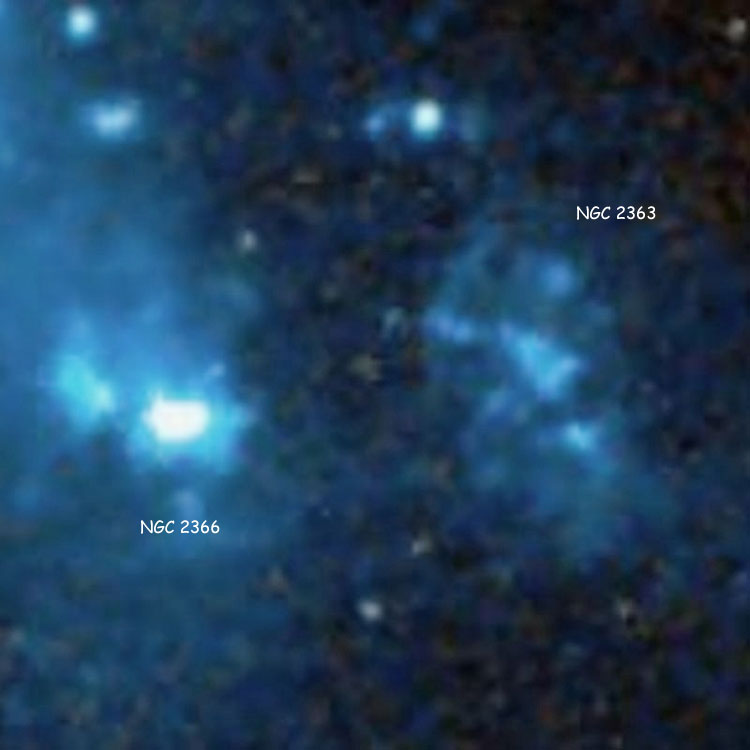
Above, a 2.4 arcmin wide closeup of the correct NGC 2363 and 2366
Below, a closeup of the original NGC 2366, often incorrectly listed as NGC 2363
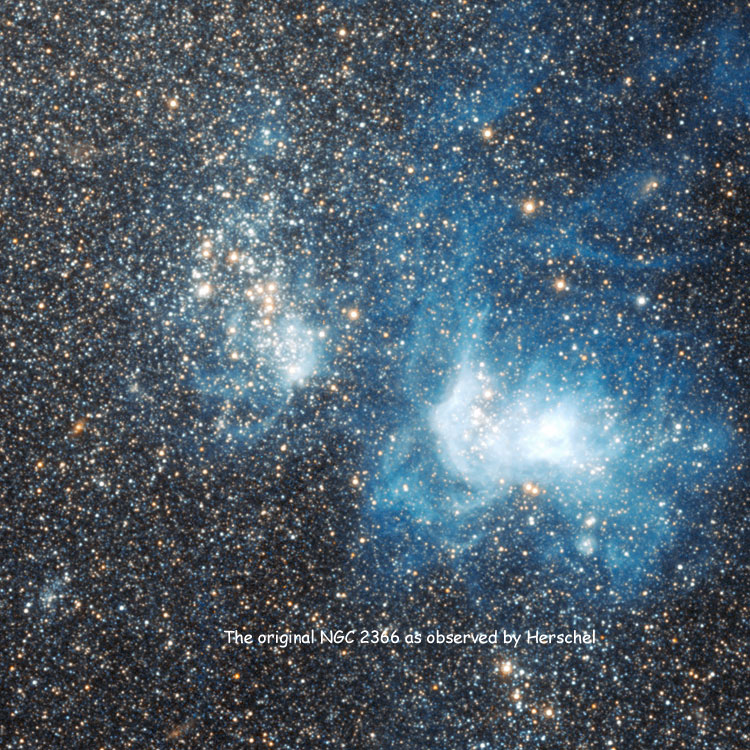
Below, a 12 arcmin wide region centered on the galaxies

NGC 2364
Discovered (Jan 8, 1831) by John Herschel
An open cluster in Monoceros (RA 07 20 46.4, Dec -07 32 58)
NGC 2365 (= PGC 20838)
Discovered (Nov 10, 1864) by Albert Marth (102)
A 12th-magnitude spiral galaxy (type SBa) in Gemini (RA 07 22 22.3, Dec +22 05 00)
Apparent size 2.8 by 1.4 arcmin
NGC 2366 (= PGC 21102)
Discovered (Dec 3, 1788) by William Herschel
An 11th-magnitude irregular galaxy (type IBm) in Camelopardalis (RA 07 28 54.8, Dec +69 12 58)
Apparent size 8.1 by 3.0 arcmin. Herschel's nebula was the bright star-forming region near the southern end of the faint galaxy extending some distance to the north (and south). In fact his original observation indicated the existence of a northern extension of the nebula. However, over the years the entire galaxy has come to be called NGC 2366, and the bright star-forming region NGC 2363, which is actually the faint companion or outlier to the west of the bright knot that was Herschel's NGC 2366. For example, the news release for the HST image shown below refers to the bright region as NGC 2363, helping to perpetuate the incorrect identification, and an earlier closeup of the star-forming region also refers to it by the incorrect name. For that reason, it would be useful to look at the images and description of the correct NGC 2363. 
Above, an 8 arcmin wide image of NGC 2366 and 2363
Below, a 2.8 by 5.5 arcmin wide closeup of NGC 2366 (Image Credits: ESA / NASA)
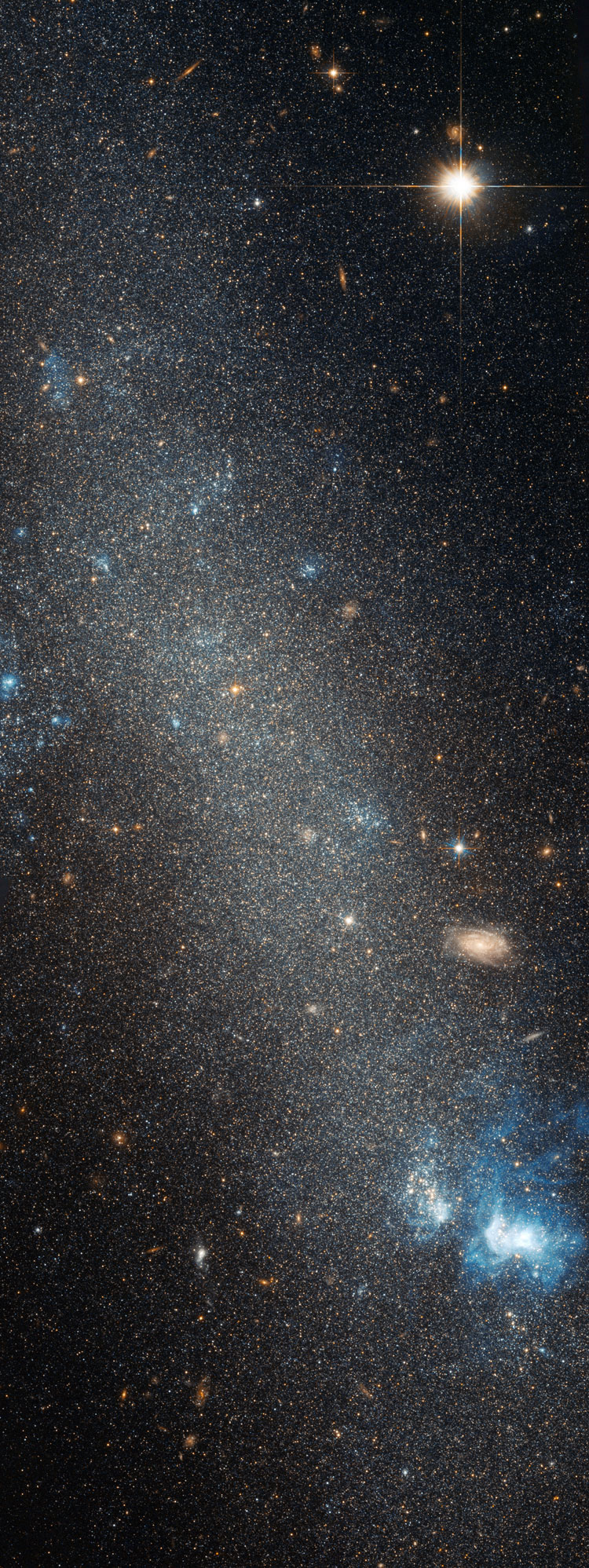
Below, a closeup of the original NGC 2366, often incorrectly listed as NGC 2363

Below, a 12 arcmin wide region centered on NGC 2366

NGC 2367 (= OCL 621)
Discovered (Nov 20, 1784) by William Herschel
An 8th-magnitude open cluster (type IV3p) in Canis Major (RA 07 20 06.0, Dec -21 52 54)
Apparent size 5.0 arcmin
NGC 2368 (= OCL 571)
Discovered (Mar 9, 1828) by John Herschel
A 12th-magnitude open cluster (type IV2p) in Monoceros (RA 07 21 02.2, Dec -10 22 28)
Apparent size 3.0 arcmin
NGC 2369 (= PGC 20556)
Discovered (Dec 26, 1834) by John Herschel
A 12th-magnitude spiral galaxy (type SBa) in Carina (RA 07 16 37.7, Dec -62 20 38)
Apparent size 3.5 by 1.1 arcmin
PGC 20640 (= "NGC 2369A")
Not an NGC object but sometimes called NGC 2369A since in general area of NGC 2369
A 13th-magnitude spiral galaxy (type SBbc) in Carina (RA 07 18 43.5, Dec -62 56 12)
Apparent size 1.8 by 1.2 arcmin
PGC 20717 (= "NGC 2369B")
Not an NGC object but sometimes called NGC 2369B since in general area of NGC 2369
A 13th-magnitude spiral galaxy (type SBbc) in Carina (RA 07 20 29.7, Dec -62 03 14)
Apparent size 1.5 by 1.4 arcmin
NGC 2370 (= PGC 20955)
Discovered (Nov 10, 1864) by Albert Marth (103)
A 14th-magnitude spiral galaxy (type SBc) in Gemini (RA 07 25 01.5, Dec +23 47 01)
Apparent size 0.8 by 0.5 arcmin
NGC 2371 ( = "PGC 3517754", and with NGC 2372 = P-K 189 +19.1)
Discovered (Mar 12, 1785) by William Herschel (and later listed as NGC 2371)
Also observed (Feb 17, 1827) by John Herschel (and later listed as NGC 2371)
Discovered (Mar 12, 1785) by William Herschel (and later listed as NGC 2372)
Also observed (Feb 17, 1827) by John Herschel (and later listed as NGC 2372)
NGC 2371/72 = A magnitude 11.2 planetary nebula in Gemini (RA 07 25 34.7, Dec +29 29 26)
NGC 2371 = Western lobe of the planetary nebula, at RA 07 25 33.8, Dec +29 29 18
NGC 2372 = Eastern lobe of the planetary nebula, at RA 07 25 35.6, Dec +29 29 32
Historical Identification: Per Dreyer, NGC 2371 (= GC 1519 = JH 444 = WH II 316, 1860 RA 07 16 44, NPD 60 14.5) is "bright, small, round, brighter middle and nucleus, western part of a double nebula". The position precesses to RA 07 25 34.0, Dec +29 29 11, right on the western lobe the planetary nebula listed above, the description fits and there is nothing else nearby save the eastern lobe representing NGC 2372, so the identification is certain.
Discovery Notes: Because of the dark region between the two parts of the planetary nebula, the Herschels (and Dreyer) listed the nebula as two separate objects; but they comprise two "lobes" of a single object.
Note About PGC Designation: For purposes of completeness, LEDA assigned a PGC designation to NGC 2371 even though it is a planetary nebula, but a search of the database for that designation returns no result, so it is shown in quotes.
Physical Information: The planetary nebula is thought to be about 4400 light years away. Given that and the apparent size of its central region of about 1.3 by 0.9 arcmin, while the outer regions to the east and west span about 2.2 by 1.5 arcmin (both apparent sizes from the images below), the central region is about 1.65 light years across, while the outer regions span about 2.8 light years. The nebula was formed by the ejection of material (in at least two episodes) by a red giant which has now collapsed to form the white dwarf in the center of the two lobes. The star clusters shown in each lobe (in the HST image) suggest that as the gas ejected by the red giant moved into interstellar space it collided with gases already there and triggered the formation of those clusters.

Above, a 12 arcmin wide DSS image centered on NGC 2371 and 2372
Below a 2.75 arcmin wide DSS image of the planetary nebula
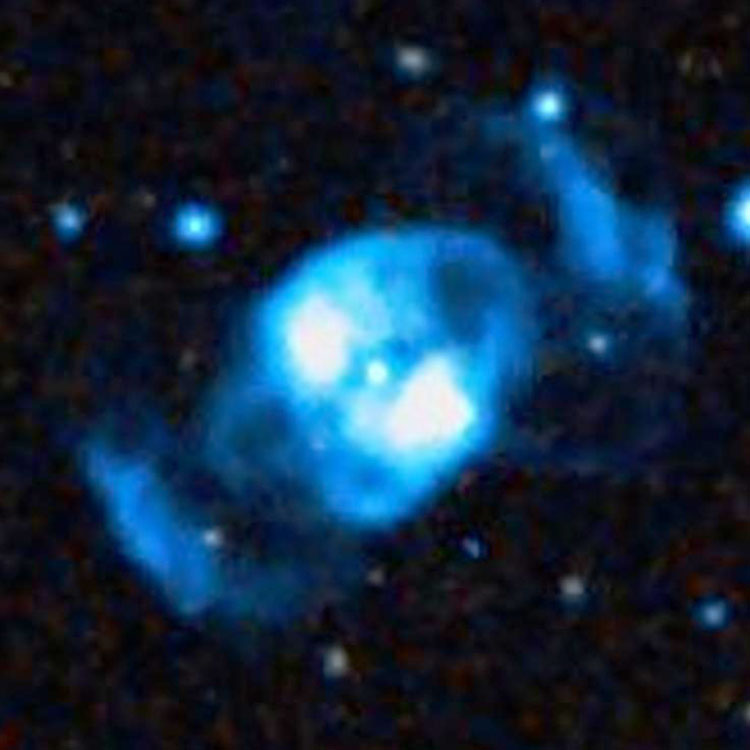
Below, a 2.75 arcmin wide PanSTARRS image of the planetary nebula
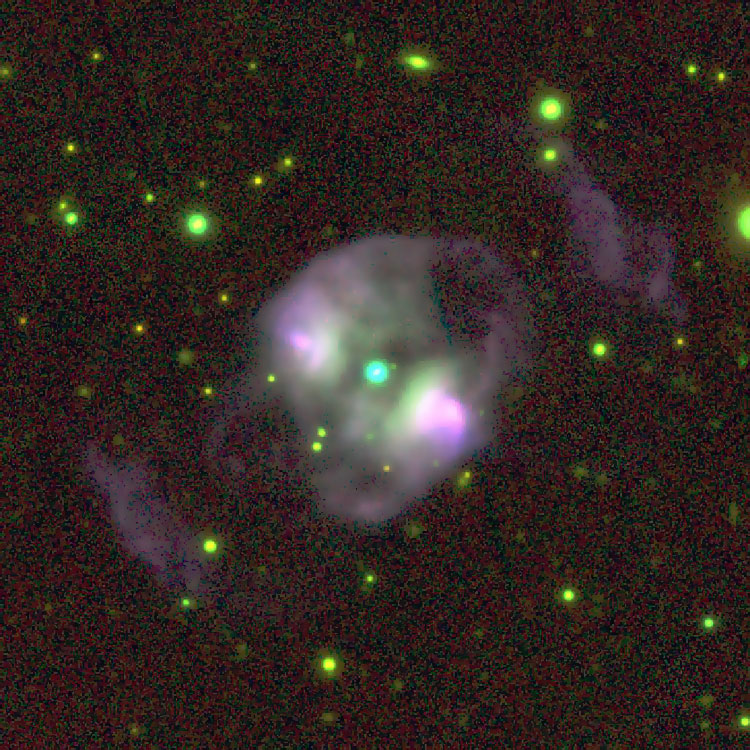
Below, a 0.8 arcmin wide image of the planetary nebula (Image Credit ESA/Hubble & NASA, Wade et al.)

NGC 2372 ( = "PGC 5067728", and with NGC 2371 = P-K 189 +19.1)
Discovered (Mar 12, 1785) by William Herschel (and later listed as NGC 2371)
Also observed (Feb 17, 1827) by John Herschel (and later listed as NGC 2371)
Discovered (Mar 12, 1785) by William Herschel (and later listed as NGC 2372)
Also observed (Feb 17, 1827) by John Herschel (and later listed as NGC 2372)
NGC 2371/72 = A magnitude 11.2 planetary nebula in Gemini (RA 07 25 34.7, Dec +29 29 26)
NGC 2371 = Western lobe of the planetary nebula, at RA 07 25 33.8, Dec +29 29 18
NGC 2372 = Eastern lobe of the planetary nebula, at RA 07 25 35.6, Dec +29 29 32
Historical Identification: Per Dreyer, NGC 2372 (= GC 1520 = JH 445 = WH II 317, 1860 RA 07 16 45, NPD 60 14.2) is "pretty bright, small, round, brighter middle and nucleus, easter parat of double nebula". The position precesses to RA 07 25 35.1, Dec +29 29 35, right on the eastern lobe the planetary nebula listed above, the description fits and there is nothing else nearby save the western lobe representing NGC 2371, so the identification is certain.
Discovery Notes: Because of the dark region between the two parts of the planetary nebula, the Herschels (and Dreyer) listed the nebula as two separate objects; but they comprise two "lobes" of a single object.
Note About PGC Designation: For purposes of completeness, LEDA assigned a PGC designation to NGC 2372 even though it is a planetary nebula, but a search of the database for that designation returns no result, so it is shown in quotes.
Physical Information: Since the two entries represent different parts of the same object, see NGC 2371 for anything else
NGC 2373 (= PGC 21016)
Discovered (Feb 20, 1849) by George Stoney
A 14th-magnitude spiral galaxy (type Sbc) in Gemini (RA 07 26 36.9, Dec +33 49 27)
Apparent size 0.6 by 0.5 arcmin
NGC 2374 (= OCL 585)
Discovered (Jan 31, 1785) by William Herschel
An 8th-magnitude open cluster (type II3p) in Canis Major (RA 07 23 56.0, Dec -13 15 48)
Apparent size 12 arcmin
NGC 2375 (= PGC 21035)
Discovered (Feb 20, 1849) by George Stoney
A 14th-magnitude spiral galaxy (type SBb) in Gemini (RA 07 27 09.4, Dec +33 49 57)
Apparent size 1.3 by 1.0 arcmin
NGC 2376 (= PGC 21015)
Discovered (Nov 10, 1864) by Albert Marth (104)
A 14th-magnitude spiral galaxy (type Sbc) in Gemini (RA 07 26 35.9, Dec +23 04 24)
Apparent size 0.6 by 0.6 arcmin
NGC 2377 (= PGC 20948)
Discovered (Jan 19, 1874) by douard Stephan (6-8)
A 13th-magnitude spiral galaxy (type Sc) in Monoceros (RA 07 24 56.7, Dec -09 39 38)
Apparent size 1.7 by 1.3 arcmin
NGC 2378
Discovered (Feb 8, 1878) by douard Stephan (9-10)
A pair of stars in Gemini (RA 07 27 23.9, Dec +33 49 55)
NGC 2379 (= PGC 21036)
Discovered (Mar 6, 1828) by John Herschel
A 14th-magnitude lenticular galaxy (type S0) in Gemini (RA 07 27 26.2, Dec +33 48 43)
Apparent size 0.9 by 0.8 arcmin
NGC 2380 (= NGC 2382 = PGC 20916)
Discovered (Feb 1, 1837) by John Herschel (and later listed as NGC 2382)
Discovered (Feb 5, 1837) by John Herschel (and later listed as NGC 2380)
An 11th-magnitude lenticular galaxy (type SB0) in Canis Major (RA 07 23 54.5, Dec -27 31 43)
Erroneous observations on two sweeps separated by 4 nights; all too common. Apparent size 2.1 by 2.0 arcmin.
NGC 2381 (= PGC 20694)
Discovered (Dec 26, 1834) by John Herschel
A 13th-magnitude spiral galaxy (type SBa) in Carina (RA 07 19 57.4, Dec -63 04 01)
Apparent size 1.4 by 1.4 arcmin
NGC 2382 (= NGC 2380 = PGC 20916)
Discovered (Feb 1, 1837) by John Herschel (and later listed as NGC 2382)
Discovered (Feb 5, 1837) by John Herschel (and later listed as NGC 2380)
An 11th-magnitude lenticular galaxy (type SB0) in Canis Major (RA 07 23 54.5, Dec -27 31 43)
(this entry to contain only historical information; for physical data and images see NGC 2380. Poor positions on two sweeps separated by 4 nights; all too common. The second IC lists a corrected position (per Howe) of RA 07 18 15, NPD 117 15.5 and adds "h.'s place only approximate".
NGC 2383 (= OCL 616)
Discovered (Feb 15, 1836) by John Herschel
An 8th-magnitude open cluster (type I3m) in Canis Major (RA 07 24 39.9, Dec -20 56 51)
Apparent size 5.0 arcmin. Near NGC 2384.
NGC 2384 (= OCL 618)
Discovered (Feb 15, 1836) by John Herschel
A 7th-magnitude open cluster (type IV3p) in Canis Major (RA 07 25 10.0, Dec -21 01 18)
Apparent size 5.0 arcmin. Near NGC 2383.
NGC 2385 (= PGC 21080)
Discovered (Feb 4, 1793) by William Herschel
A 14th-magnitude spiral galaxy (type S?) in Gemini (RA 07 28 28.2, Dec +33 50 17)
Apparent size 1.0 by 0.7 arcmin
NGC 2386
Recorded (Jan 1, 1876) by Lawrence Parsons, 4th Earl of Rosse
A pair of stars in Gemini (RA 07 28 38.1, Dec +33 46 35)
NGC 2387 (= PGC 21105)
Discovered (Mar 10, 1790) by William Herschel
A 15th-magnitude spiral galaxy (type S) in Auriga (RA 07 28 57.9, Dec +36 52 47)
Apparent size 0.6 by 0.5 arcmin
NGC 2388 (= PGC 21099)
Discovered (Feb 4, 1793) by William Herschel
A 14th-magnitude spiral galaxy (type S) in Gemini (RA 07 28 53.5, Dec +33 49 08)
Apparent size 1.0 by 0.6 arcmin
NGC 2389 (= PGC 21109)
Discovered (Feb 5, 1788) by William Herschel
A 13th-magnitude spiral galaxy (type SBc) in Gemini (RA 07 29 04.8, Dec +33 51 39)
Apparent size 2.0 by 1.4 arcmin
NGC 2390
Discovered (Dec 10, 1866) by Robert Ball
A 13th-magnitude star in Gemini (RA 07 29 04.2, Dec +33 50 13)
NGC 2391
Discovered (Dec 10, 1866) by Robert Ball
A 15th-magnitude star in Gemini (RA 07 29 07.6, Dec +33 49 33)
NGC 2392, the Eskimo Nebula, the Clown Face Nebula
(= C39 = PK 197+17.1 = HD 59088 = "PGC 2860341")
Discovered (Jan 17, 1787) by William Herschel
A 9th-magnitude planetary nebula in Gemini (RA 07 29 10.8, Dec +20 54 45)
Historical Identification: The second IC says "About its spectrum see Pickering, [ A.N.] 4089, p.141". (Not relevant to a determination of its identification, but perhaps of interest to some readers.)
Note about PGC Designation: As usual for NGC objects, HyperLEDA assigned a PGC designation to NGC 2392, even though it isn't a galaxy; but as also usual in such cases, a search of the database for that designation returns no result, so it is shown in quotes.
Physical Information:
NGC 2392 is a double shell planetary nebula, consisting of a white dwarf (a formerly Sun-like star) surrounded by two regions ejected by the star. The outer "shell" is believed to be a dense, slow-moving (approximately 20 miles per second) structure ejected from the equatorial region of the star when it was a red giant, ten thousand years ago. The gas in the outer region is moving outward at about 20 miles per second. The inner region consists of two elliptical lobes emitted by the polar regions of the star, approximately directly toward and away from us (so that the front lobe mostly obscures the back one). The gas in this lobe is moving much faster (from 60 to 120 miles per second), and is much hotter (3 to 4 million Fahrenheit degrees) than the gas in the outer shell. NGC 2392 is about 3000 light years away. Given that and its apparent size of 0.8 by 0.7 arcmin, it is about 0.7 light years across. (This contradicts frequently-quoted estimates of the linear structures in the outer shell being a light year in length, as they can't be larger than the entire nebula.) Note: Searching for NGC 2392 in Wikisky brings up the wrong object, spiral galaxy PGC 21128.
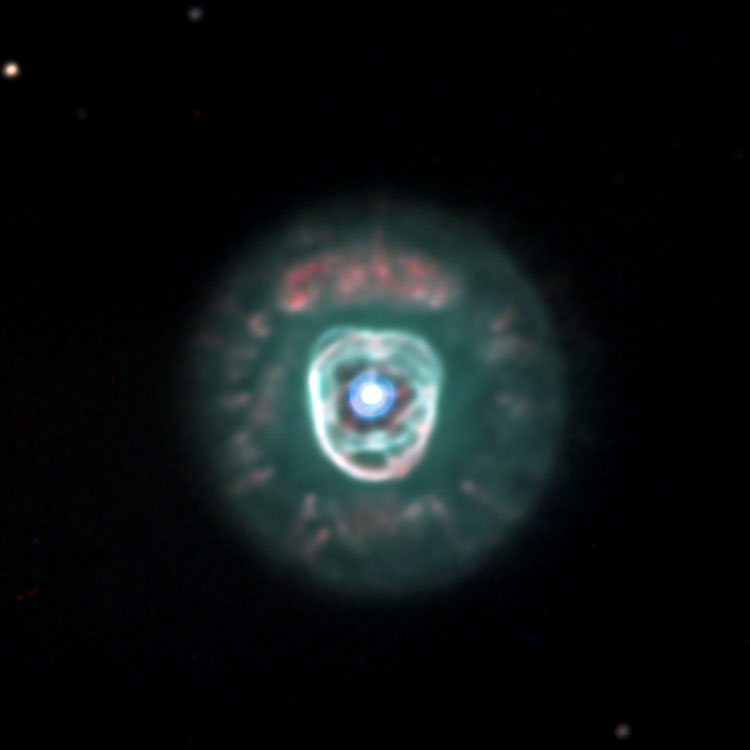
Above, a (1 arcmin?) wide closeup of NGC 2392 (Credit: Peter and Suzie Erickson/Adam Block/AURA/NSF/NOAO)
Below, a 12 arcmin wide region centered on the (overexposed) nebula

Below, another closeup of the nebula (Image Credit Andrew Fruchter (STScI) et al., WFPC2, HST, NASA)
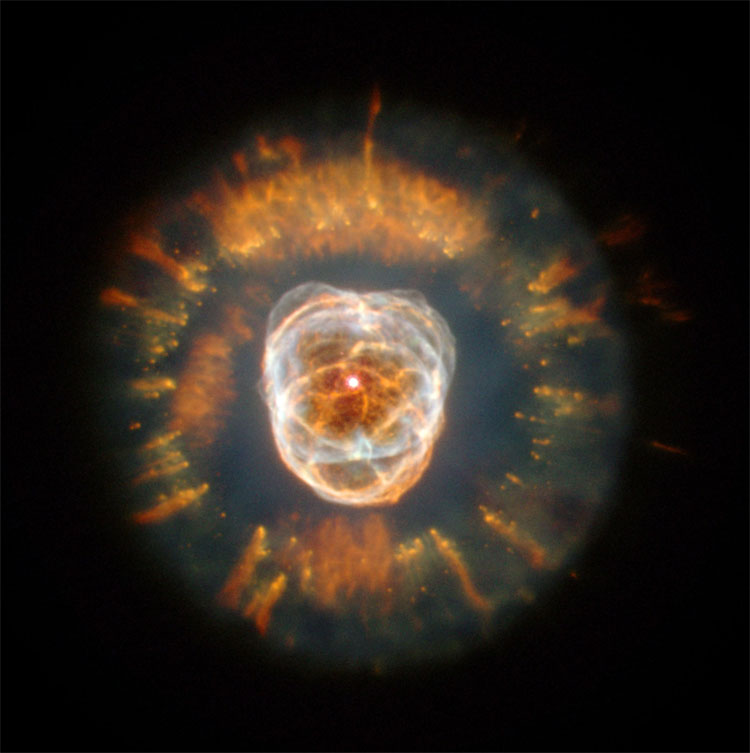
PGC 21128
Not an NGC object; listed here because of misidentification as NGC 2392, noted above
A 14th-magnitude spiral galaxy (type SBa?) in Gemini (RA 07 29 28, Dec +20 03 18)
Based on a recessional velocity of 4525 km/sec, PGC 21128 is about 210 million light years away. Given that and its apparent size of 0.75 by 0.4 arcmin, it is about 45 thousand light years across.
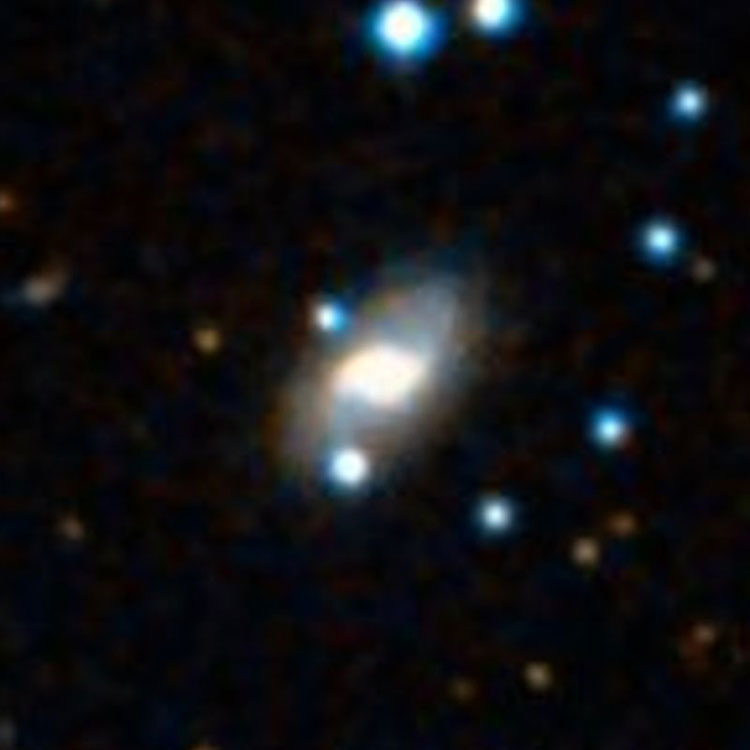
Above, a 2.4 arcmin wide closeup of PGC 21128
Below, a 12 arcmin wide region centered on the galaxy

NGC 2393 (= PGC 21154)
Discovered (Feb 7, 1885) by douard Stephan (13-28)
A 14th-magnitude spiral galaxy (type Sc) in Gemini (RA 07 30 04.9, Dec +34 01 40)
Apparent size 1.2 by 0.8 arcmin
NGC 2394
Discovered (Dec 28, 1785) by William Herschel
A group of stars in Canis Minor (RA 07 28 36.5, Dec +07 05 14)
NGC 2395 (= OCL 502)
Discovered (Mar 16, 1784) by William Herschel
An 8th-magnitude open cluster (type III1p) in Gemini (RA 07 27 12.8, Dec +13 36 30)
A cluster of about twenty stars about 1350 light years away. Given that and its apparent size of 15 arcmin, about 6 light years across. The cluster appears to have lost most of its original stars (particularly the lower-mass ones) due to gravitational interactions with non-cluster stars, as it orbited the galaxy over the approximately billion and a half years since its formation. (In the image below, the bright reddish stars near the center are K-type red giants whose characteristics were used to establish the age of the cluster.)

Above, a 24 arcmin wide view of NGC 2395
Below, a 1.1 degree wide view, to also show the position of the Medusa Nebula (at lower left)

Abell 21, the Medusa Nebula
Not an NGC object; temporarily listed here because in wide-field view for NGC 2395
A 16th-magnitude planetary nebula in Gemini (RA 07 29 02.7, Dec +13 14 48)
An old planetary nebula, about 1500 light years away and 4 light years across. Discovered by George Abell in 1955, its large size gives it a very low surface brightness, making it a difficult object for small telescopes unless special filters are used to distinguish it from the background. Originally thought to be a supernova remnant, but velocity expansion studies in the early 1970's showed it was more likely to be a planetary nebula.

Above, a closeup of Abell 21 (Credits: T. A. Rector (U. of Alaska Anchorage), H. Schweiker, NOAO/AURA/NSF)
For now, see NGC 2395 for a wide-field view
NGC 2396 (= OCL 579)
Discovered (Jan 31, 1785) by William Herschel
A 7th-magnitude open cluster (type III3p) in Puppis (RA 07 28 00.0, Dec -11 43 00)
Apparent size 10 arcmin
NGC 2397 (= PGC 20766)
Discovered (Feb 21, 1835) by John Herschel
A 12th-magnitude spiral galaxy (type Sb) in Volans (RA 07 21 19.5, Dec -69 00 05)
Apparent size 2.5 by 1.2 arcmin
PGC 20754 (= "NGC 2397A")
Not an NGC object but sometimes called NGC 2397A since in general area of NGC 2397
A 14th-magnitude spiral galaxy (type Sc) in Volans (RA 07 21 07.9, Dec -69 06 55)
Apparent size 1.1 by 0.9 arcmin
PGC 20813 (= "NGC 2397B")
Not an NGC object but sometimes called NGC 2397B since in general area of NGC 2397
A 14th-magnitude irregular galaxy (type IBm pec) in Volans (RA 07 21 55.7, Dec -68 50 45)
Apparent size 0.9 by 0.5 arcmin
NGC 2398 (= PGC 21165 + PGC 21157)
Discovered (Feb 10, 1885) by douard Stephan (13-29)
A pair of galaxies in Gemini
PGC 21165 = A 14th-magnitude spiral galaxy (type S?) at RA 07 30 16.2, Dec +24 29 17
PGC 21157 = A 15th-magnitude spiral galaxy (type S? diffuse ring) at RA 07 30 13.6, Dec +24 29 29
The second IC notes (per Javelle III) "seems to be a double nebula". PGC 21165 apparent size is 1.2 by 0.8 arcmin, recessional velocity is 8910 km/sec. PGC 21157 apparent size is 0.8 by 0.7 arcmin, recessional velocity is 9600 km/sec. The recessional velocities are close enough that the pair must be at about the same distance from us, but different enough that they are unlikely to be a physical pair. But rather oddly, it appears that the apparently smaller galaxy lies in front of the apparently larger one, as its dusty outer regions seem to be obscuring part of the other galaxy; whereas their recessional velocities would suggest that if anything, the smaller one should be further away. So barring better data, which is closer or further, or whether they are an actual physical pair, remains to be seen.
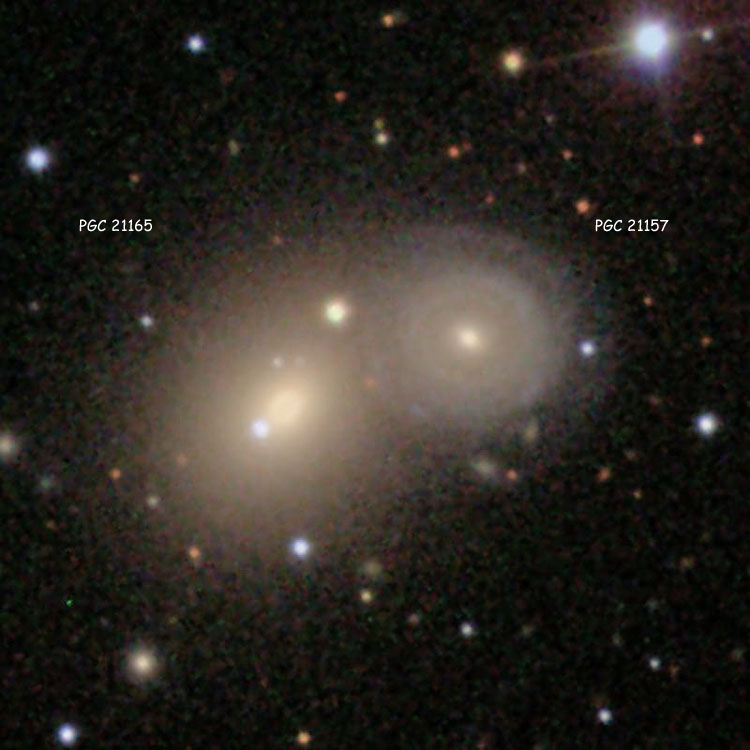
Above, a 2.4 arcmin wide closeup of the pair of galaxies listed as NGC 2398
Below, a 12 arcmin wide region centered on the pair
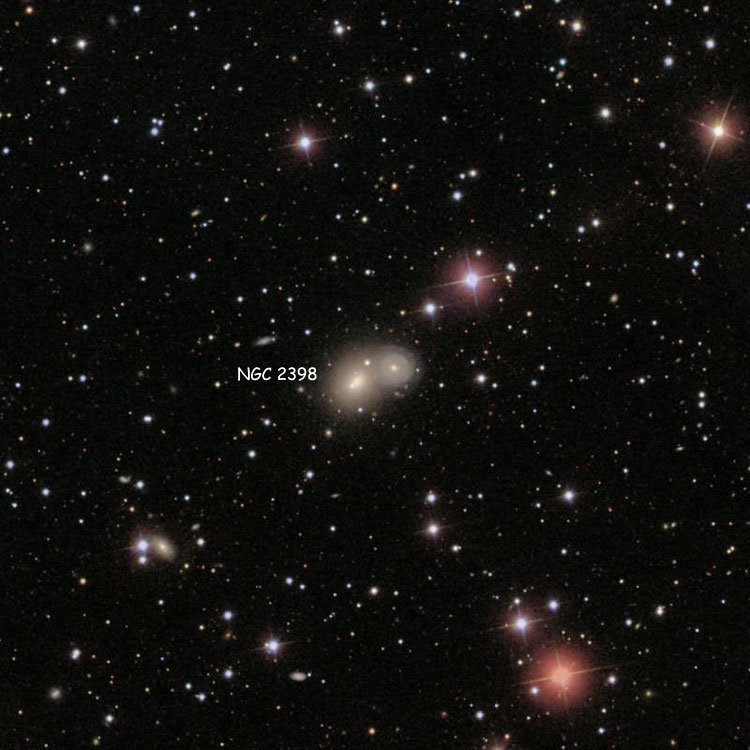
NGC 2399
Recorded (Feb 26, 1853) by George Bond
Three 13th, 14th and 15th magnitude stars in Canis Minor (RA 07 29 49.9, Dec -00 12 49)
Per Dreyer, NGC 2399 (= Bond (#9, HN 9), 1860 RA 07 22 41, NPD 89 55.6) is one of "two faint nebulae (Auwers 24 & 25), ? very small clusters", the other being NGC 2400 (which see for an image of the two NGC objects). The position precesses to RA 07 29 51.0, Dec -00 12 48, almost dead center on the triplet of stars; so the identification is certain. Note: A Wikisky search for NGC 2399 shows a position close to NGC 2400, and does not indicate any NGC label; so use the coordinates to see the correct triplet. 
Above, a 12 arcmin wide region centered on NGC 2400; also shown is the similar triple, NGC 2399
|